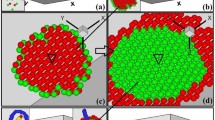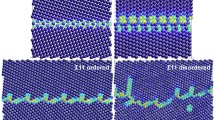Abstract
Dislocations are the most important element in our understanding of the mechanical response of metals. Their postulation in 1934 led to revolutionary advances in our ability to predict the mechanical behavior of materials. The authors recently advanced a dislocation mechanism for void growth in ductile metals. This paper reviews the analytical and atomistic calculations carried out in support of this model. The emission of shear dislocation loops, nucleated at the surface of nanosized voids, is responsible for the outward flux of matter, promoting void growth. This is a new paradigm in the initiation of void growth, which was attributed to convergent vacancy diffusion or to prismatic loops by others. The analytical treatment is based on the emission of a dislocation from a void in the plane along which the shear stresses are maximum. Molecular dynamics calculations performed for different orientations of the tensile axis show how the loops generate and expand outward. These loops involve the emission of partial dislocations and are the counterpart for voids of the Ashby geometrically necessary shear loops postulated for rigid particles. This process is demonstrated for bicrystalline and nanocrystalline copper.
Similar content being viewed by others
References
G.I. Taylor, Proc. Roy. Soc., 145 (1934), p. 362.
E. Orowan, Z. Physik, 89(1934), p. 634.
M. Polanyi, Z. Physik, 89(1934), p. 660.
T. von Karman, Enzyklopedie der Mathematischen Wissenschaften, ed. F. Klein and G. Muller, Vol. IV, pt. 4 (Leipzig, Germany: Teubner, 1913), p. 767.
L. Prandtl, Z. Angew. Math. Mech., 8 (1928), p. 85.
A. Seeger, Mat. Sci. Eng. A, 370 (2004), pp. 50–66.
R. Becker and E. Orowan, Z. Physik, 79 (1932), p. 566.
J.M. Burgers, Proc. Kon. Ned. Akad. Wetenschap., 42 (1939), pp. 293, 378.
E. Orowan, Proc. Phys. Soc. (London), 52 (1940), p. 8.
F.C. Frank and W.T. Read, Symposium on Plastic Deformation of Crystalline Solids (Pittsburgh, PA: Carnegie Institute of Technology, 1950), p. 44.
A. Seeger, Z. Naturf., 9A (1954), pp. 758, 819, 856.
P. Hirsch, R.W. Horne, and M.J. Wheelan, Phil. Mag., 1 (1956), p. 677.
W.G. Johnson and J.J. Gilman, J. Appl. Phys., 33 (1959), p. 129.
J. Weertman, J. Appl. Phys., 26 (1955), p. 1213.
J. Weertman, J. Appl. Phys., 38 (1967), p. 5293.
A.H. Cottrell and B.A. Bilby, Proc. Phys. Soc. (London), A62 (1949), p. 49.
F.R.N. Nabarro, Proc. Phys. Soc., 59 (1947), p. 256.
H. Conrad, J. Metals, 16 (1964), p. 582.
M.F. Ashby, Phil. Mag., 19 (1969), p. 757.
U.F. Kocks, Met. Trans., 1 (1970), pp. 1121–1143.
D. Kuhlmann Wilsdorf, Met. Trans., 11A (1985), p. 2091.
J.P. Hirth and J. Lothe, Theory of Dislocations (New York: McGraw-Hill, 1968).
F.J. Zerilli and R.W. Armstrong, J. Appl. Phys., 61 (1987), p. 1816.
L.B. Freund, J. Appl. Mech., 54 (1987), pp. 553–557.
W.D. Nix, Met. Trans., 20A (1989), pp. 2217–2245.
J.C.M. Li, Trans. Met. Soc. AIME, 227 (1963), p. 239.
F. Seitz, Phys. Rev., 79 (1950), p. 723.
L.M. Brown, Phil. Mag., 21 (1970), p. 329.
J. Silcox and P.B. Hirsch, Phil. Mag., 4 (1958), p. 72.
F.J. Humphreys and P.B. Hirsch, Proc. Roy. Soc. London, 318 (1970), pp. 73–92.
B.P. Uberuaga et al., Phys. Rev. Lett., 99 (2007), p. 135501.
A.L. Stevens, L. Davison, and W.E. Warren, J. Appl. Phys., 43 (1972), p. 4922.
M.A. Meyers and C.T. Aimone, Prog. in Matls. Sci., 28 (1983), p. 1.
D. Broek, Elementary Engineering Fracture Mechanics (Boston, MA: Martinus Nijhoff Publishers, 1986).
A.M. Cuitiño and M. Ortiz, Acta Mater., 44 (1996), p. 863.
R. Raj and M.F. Ashby, Acta Metal., 23 (1975), p. 653.
V.A. Lubarda et al., Acta Mater., 53 (2004), p. 1397.
S. Traiviratana et al., Acta Mater., 56 (2008), p. 3874.
J.R. Rice and R. Thomson, Phil. Mag., A29 (1974), p. 73.
A.L. Gurson, J. Eng. Mat. Tech., 99 (1977), p. 2.
S.J. Plimpton, J. Comp. Phys., 117 (1995), p. 1.
M.S. Daw and M.I. Baskes, Phys. Rev. B, 29 (1984), p. 6443.
Y. Mishin et al., Phys. Rev. B, 63 (2001), p. 224106-1.
C.L. Kelchner, S.J. Plimpton, and J.C. Hamilton, Phys. Rev. B, 58 (1998), p. 11085.
R.E. Rudd and J.F. Belak, Comp. Mater. Sci., 24 (2002), p. 148.
E.T. Seppälä, J.F. Belak, and R.E. Rudd, Phys. Rev. B, 69 (2004), p. 134101-1–19.
E.T. Seppälä, J. Belak, and R.E. Rudd, Phys. Rev. Lett., 93 (2004), p. 245503-1–4.
E.T. Seppälä, J. Belak, and R.E. Rudd, Phys. Rev. B, 71 (2005), p. 064112-1–10.
J. Marian, J. Knap, and M. Ortiz, Phys. Rev. Lett., 93 (2004), p. 1.
J. Marian, J. Knap, and M. Ortiz, Acta Mater., 53 (2005), p. 2893.
S.G. Srinivasan, M.I. Baskes, and G.J. Wagner, J. Mater. Sci., 41 (2006), p. 7838.
D.C. Ahn et al., Appl. Phys., 101 (2007), p. 063514-1–6.
G.P. Potirniche et al., Int. J. Plasticity, 22 (2006), p. 257.
W. Zhu et al., Phys. Rev. B, 75 (2007), p. 024104-1.
L.P. Davila et al., Appl. Phys. Lett., 86 (2005), p. 161902.
H. van Swygenhoven, M. Spaczer, and A. Caro, Acta Mat., 47 (1999), p. 561.
S. Christy, H.-R. Pak, and M.A. Meyers, Metallurgical Applications of Shock Wave and High-Strain-Rate Phenomena (New York: Marcel Dekker, 1986), pp. 835–863.
F.C. Frank and J.H. van der Merwe, Proc. Roy. Soc., A198 (1949), pp. 205, 216.
J.H. van der Merwe, J. Appl. Phys., 34 (1963), pp. 123–127.
H. Mughrabi, Mat. Sci. Eng., 33 (1978), p. 207.
E. Kröner, Zeitsch. Fur Physik, 151 (1958), p. 504.
J.R. Rice, J. Mech. Phys. Sol., 40 (1992), p. 239.
V.V. Stegailov and A.V. Yanilkin, Shock Compression of Condensed Matter-2007 (College Park, MD: American Physical Society, 2008), pp. 329–334.
V.V. Stegailov et al., Shock Compression of Condensed Matter-2007 (College Park, MD: American Physical Society, 2008), pp. 339–342.
G.W. Nieman, J.R. Weertman, and R.W. Siegel, J. Materials Research, 6 (1991), pp. 1012–1027.
J. Shiøtz, F.D. Di Zolla, and K.W. Jacobsen, Nature, 391 (1998), p. 561.
W.G. Wolfer, Philos. Mag. A, 58 (1988), p. 285.
Author information
Authors and Affiliations
Corresponding author
Rights and permissions
About this article
Cite this article
Meyers, M.A., Traiviratana, S., Lubarda, V.A. et al. The role of dislocations in the growth of nanosized voids in ductile failure of metals. JOM 61, 35–41 (2009). https://doi.org/10.1007/s11837-009-0025-7
Published:
Issue Date:
DOI: https://doi.org/10.1007/s11837-009-0025-7




